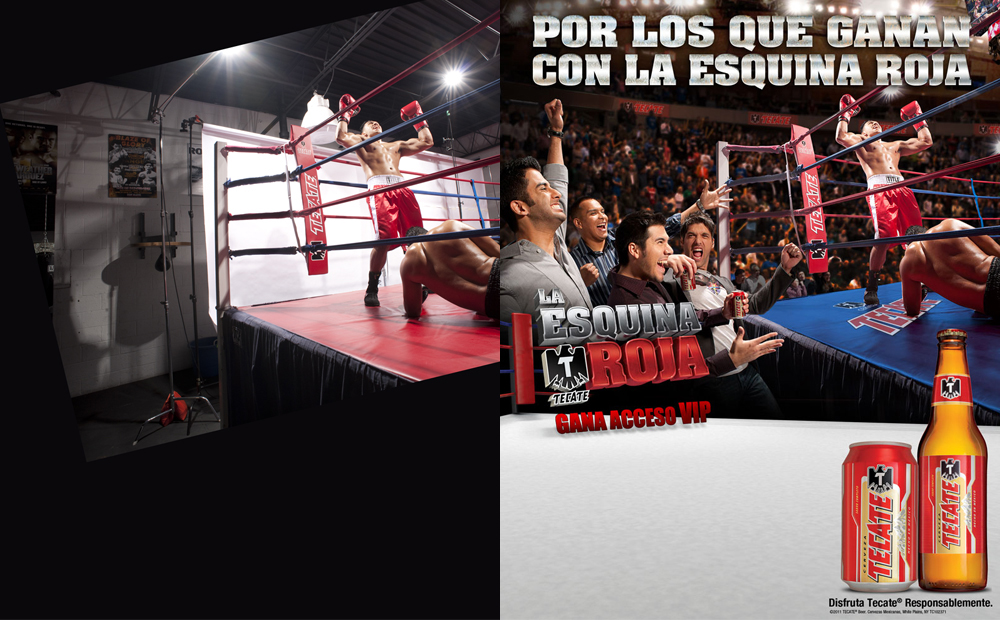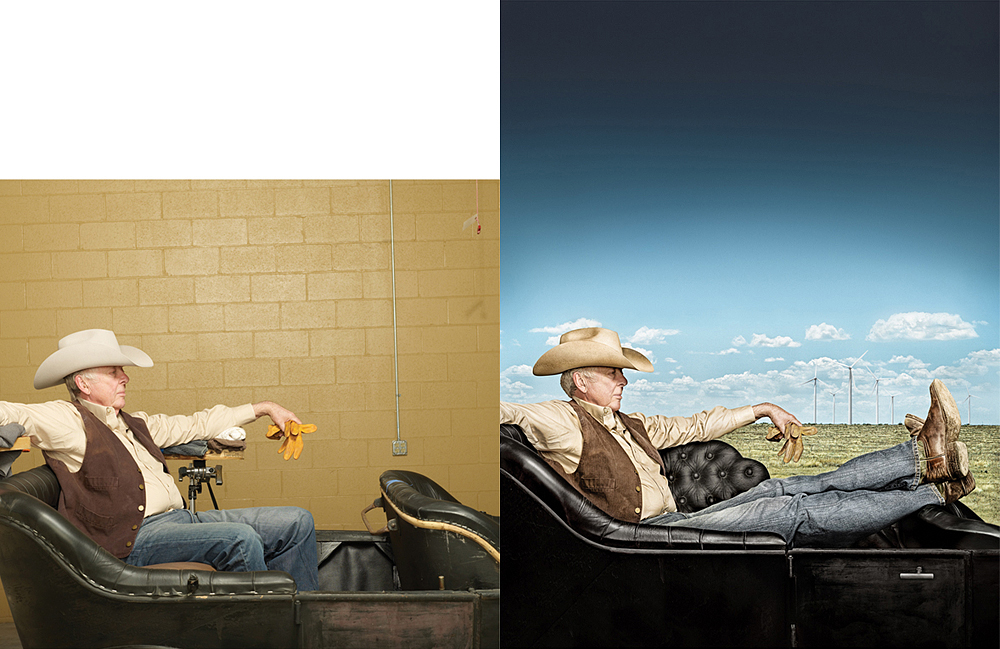Interview by guest contributor John Davidson
You’ve probably seen the work of Allison Hughes in advertisements, on magazine covers and in editorial features – though you may not be aware of it. Allison is one of the pre-eminent commercial Photoshop artists in Texas – an area of commercial photography that is growing exponentially, and which figures to continue doing so throughout the foreseeable future.
Allison has worked as a freelance retouch artist since 2007, having previously worked at GSDM, in Austin. She lives in South Austin with her husband, Ryan, stepdaughter, Haylee (6), son, Rusty (3) and daughter, Rosie (7 months). She’s originally from North Carolina.
You work freelance – do you have an office, or do you work from home?
From home. My husband works for Dell, and he works out of a home office too. It’s both good and bad (Laughs). We have that flexibility, which is good because in my work I’m usually the last step in the process, so we’re usually coming up to a deadline, and I need to step up right away. I’m used to that aspect of the job, it’s fine; it’s a part of my job.
How did you come to be in the imaging business?
I went to East Carolina University, in North Carolina, and my degree…
Wait a second. It’s called East Carolina University, it’s in North Carolina, and yet you maintained faith that you’d earn a degree of some value there?
(Laughs) Have you heard of it? It’s known as a big party school, but it has a great arts program. My degree was in Image Design, which is a Fine Arts degree. Part of the program was traditional analog photography, so I learned to work in a darkroom, and the other half involved working on the computer, retouching on Photoshop. I loved the developing classes. I liked shooting some, too, but I always loved the darkroom and the concept side of art better. I would live in the darkroom, stay in there trying to do different effects. I mean, that side of things is dead now, everything’s done on computer.
I loved the developing classes. I liked shooting some, too, but I always loved the darkroom and the concept side of art better
Well, it’s a true craft, and because of that I’m not sure it will ever die completely. It reminds me a little of people still feeling a love for vinyl music. It has pocket resurgences that relate to a kind of authenticity…
But commercially, everything’s done digitally now. But when I graduated I was referred to a small commercial photography studio, working for Jimmy Williams. There were only four or five us working there, so I learned the pre-production side of things too, like building estimates, casting, constructing props, and I got to be in the studio and see the shoots. Actually, my first job at the studio after leaving school was for GSDM, for Land Rover. Jimmy had a relationship with David Crawford one of the creative directors at the agency, and I kept in touch with him. Several years later, when GSDM won the account for BMW they were looking for another retoucher – David asked me if I was interested, and so I came out here.
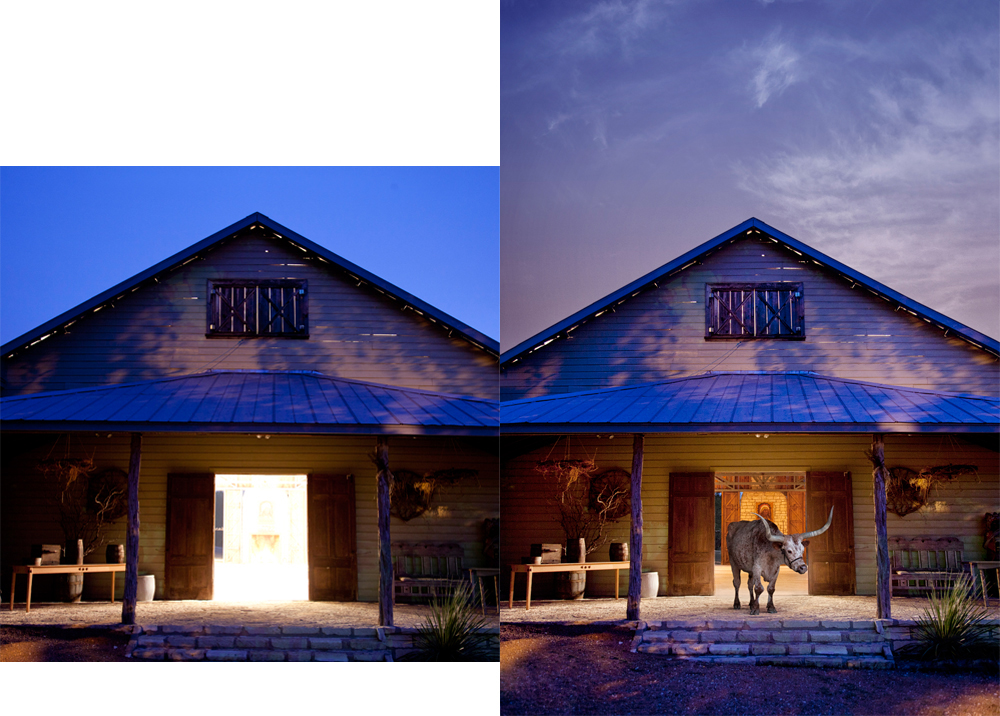
Cattle for Spirit Magazine, ©Matt Rainwaters
It must have been nice to be talent scouted rather than have to come looking…
It was but then shortly after I got here GSDM lost some big accounts, so you know, last one in, first one out. But I loved it here and wanted to stay so that’s when I went freelance.
So how long have you been freelancing?
Since ‘07. I also did a bit of freelance while I was at GSDM for my past agency. I worked at McKinney Silver in North Carolina after I worked at Jimmy Williams, and I did a lot of work on car accounts there. They had Audi USA. That’s one of the things that helped me get the GSDM job, since they’d just got the BMW account. I’d visited Austin a couple of times and loved it, and I had one friend here. I was ready for a change. I was at GSDM about two years.
Do you still love Austin?
A: (Sighs luxuriantly, leaving little doubt as to her affection for the city) I met my husband here, and now three kids later… I think my parents thought it was temporary, but I don’t see myself leaving. I just love the people, love how casual it is.
Is there such a thing as a typical workweek for you?
It varies. But I feel like I’m always at my computer, whether I’m working or not. Sometimes it’s hard tearing myself away from it. But normally I work in the morning for about 4 hrs, and then I have my kids. They take a nap, so I’ll work some more, and then I’ll work again at night.
Are you at the computer at some ungodly hour to work those first four hours?
The kids are in half-day care, so I’ll work while they’re there. But if I have a big job, I’ll hire a nanny, or my husband will come in and take care of them. It’s still fairly fluid; we’re still working it out. But usually we do work it out. It’s a legitimate concern, because you don’t want to lose a client. I always say ‘I’ll do it’ and then figure it out. Because the minute you say ‘no’ they can find somebody else and maybe they’ll like them just as much.
I presume you work on a tablet?
I do.
What kind of monitor do you use?
I have two screens. My husband works for Dell and I was able to switch from an Apple monitor to a Dell, which I love. I work on a Mac Pro (Quad Core Intel Xeon) tower, and my main monitor is a 30” Dell U3011. My second monitor is a 27” Apple Cinema HD, which I prefer to the newer, glossy Apple monitors. There’s too much reflection in the newer ones. But my new Dell monitor is huge! I love it.
Given how many hours you spend looking at monitors every day, do you feel like it’s adversely affected your eyesight?
I do. Although they say pregnancy can affect your eyesight too. But either way, I’ve had to get reading glasses for my work. I work in a completely darkened room, and sometimes, say after 12 hours of working, you’re definitely aware of the strain.
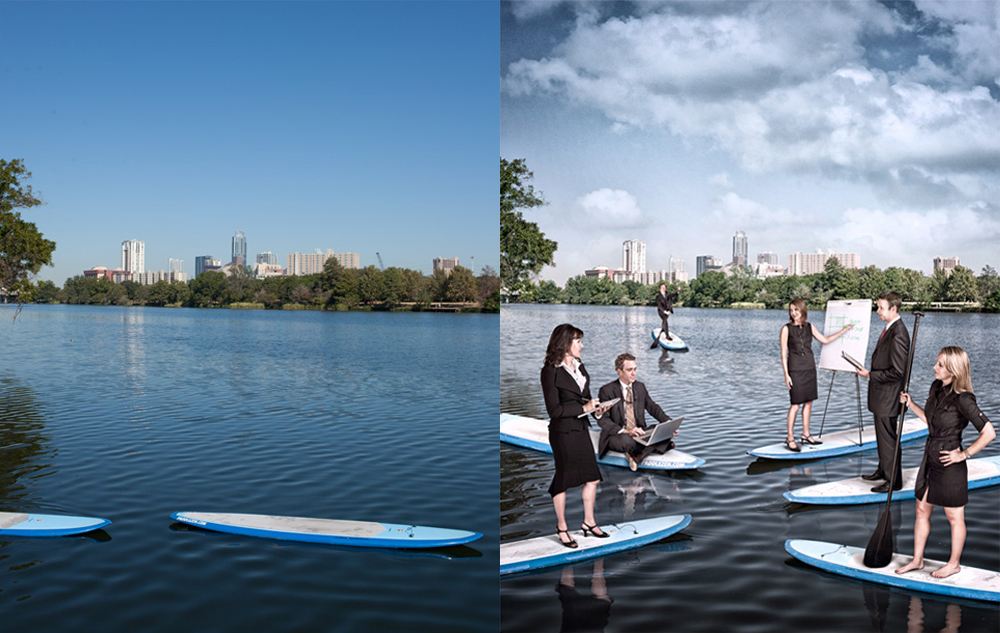
Paddleboarders for Moreland Properties, ©Michael Thad Carter, Agency Frank + Victor
Do you get up and walk around, as prescribed by opticians?
Oh yeah. But also, I’ve learned that especially working on big jobs, where you’ve been looking at an image for several hours, you have to get away from it to see it, to get a real perspective. A lot of times, even if I finish a job at the end of the day or night, I won’t send it to the client until the next day if I can help it, so that I know I’m happy with it, that I haven’t taken it in the wrong direction.
By ‘wrong direction,’ are you typically looking to see if you’ve gone too far with the processing?
No, I’m looking to make sure it’s what the client wants. You may think it looks good, but you always have to keep in mind whether it’s what the client wants. Because you don’t want to show them several versions. You want to get it one, maybe have a couple of rounds of revisions and be done with it.
You may think it looks good, but you always have to keep in mind whether it’s what the client wants
Do you keep up to date on the latest software updates? And how do you go about learning the newest versions – do you simply explore, or do you take classes/seminars?
I usually wait until I’m not too busy with work. Right now I need to update my Photoshop but I just haven’t had time. I’m still on Photoshop 5 but I don’t want to switch and learn while I’m busy. I usually wait until there’s something I need to learn and then look it up. But I should do more because you always need to learn, find new ways or see if there’s an easier or better way.
What you’re particularly looking for are quicker ways to do things?
Right. That’s the most important thing commercially, knowing the best way to do things in the least amount of time. But you know there’s a lot of new tools that are supposed to save you time and they’re not the best, cleanest way. As far as things like clipping on images, there are tools now that allow you fix things more quickly, but it’s not the best way. Sometimes you’re better taking your time.
How often does work come back to you for correction?
Usually if you work with photographers or creative directors, they’re going to want to give you some kind of feedback. Even if they love it they’ll come back with something. Usually when I estimate jobs I allow for a couple of rounds of revisions. But I do have some clients who give me full freedom, including over the final look.
When you heard from GSD&M, were you already thinking of trying to go freelance?
I’d actually been talking about it with another girl. I was already freelancing work for some companies in North Carolina. It’s hard to go freelance when you have a full-time job because you’re scared to leave. So when that happened with GSD&M…there aren’t a lot of other big agencies in Austin that have retouchers in-house. I’d just met my husband, and I thought, if I’m ever going to try to do it, it’s now. But I had so much support, so many friends and art directors that wanted to help me out. They referred me to so many people in town. It was incredible.
You clearly do amazing work. I wonder if you think that there’s any point at which there should be a re-touching credit? Perhaps more so with editorial work…
(Hesitates) Sometimes I do. Sometimes with heavy compositing, or with work where, before and after the difference is just incredible because of the amount of work that’s gone into it. I do occasionally ask for a credit, but it’s such a hard thing because your job is to be in the background. The photographer, the client especially, they don’t want to let the world know…
I do occasionally ask for a credit, but it’s such a hard thing because your job is to be in the background
…That the image is a fiction, an illusion?
Well, it’s their image. And I’m just the facilitator who makes it happen because maybe they don’t have the time or the skills to do it. But it is their image. And I have some clients who don’t want to display the work on my website even because it’s their image.
There’s a certain generosity from someone like, Randal Ford, for example, who does allow you to use some of his heavily retouched images on your site.
But the thing with Randal is that he’s really skilled at re-touching; he knows his stuff. He used to do a lot of it and I think the busier he gets, he just needs someone to help him with that side of things. There are some photographers who really don’t know that side of things and some, like Randal, who really do and just need some help.
So yeah, it’s a fine line, because you’d like credit for the work you’ve done, and you’d like to be able to show that work, but at the same time, it’s important that the photographer and the client are completely happy. So I don’t really have a problem with it.
Obviously the image belongs to the person who conceived and shot it. But I wonder, given how prevalent re-touching is in publishing – because there’s literally not an image you see in a magazine that hasn’t been worked over, even if not heavily so – will we at some point take it for granted that there was re-touching involved, and so we’ll feel less concerned at shattering the ‘illusion,’ and therefore be able to provide due credit?
I hope so. Because when there is heavy re-touching, there is artistry to it. But my philosophy has always been that if it’s work I’m proud of, let me show it, and other than that, I just want you to refer me to other clients.
You mention artistry, and that’s one key to this particular argument. How much of what you do is artistry, how much of it comes from your fine arts background, and how much is mere computer technique?
I think knowledge of the tools and the software, of the process – how to prepare files, for example – is technical, but knowing when and how to use the tools, and having an aesthetic, is creative.
In the wrong hands, a little Photoshop proficiency can be a dangerous thing…
Right. When you look at an image, you shouldn’t be thinking about the re-touching.
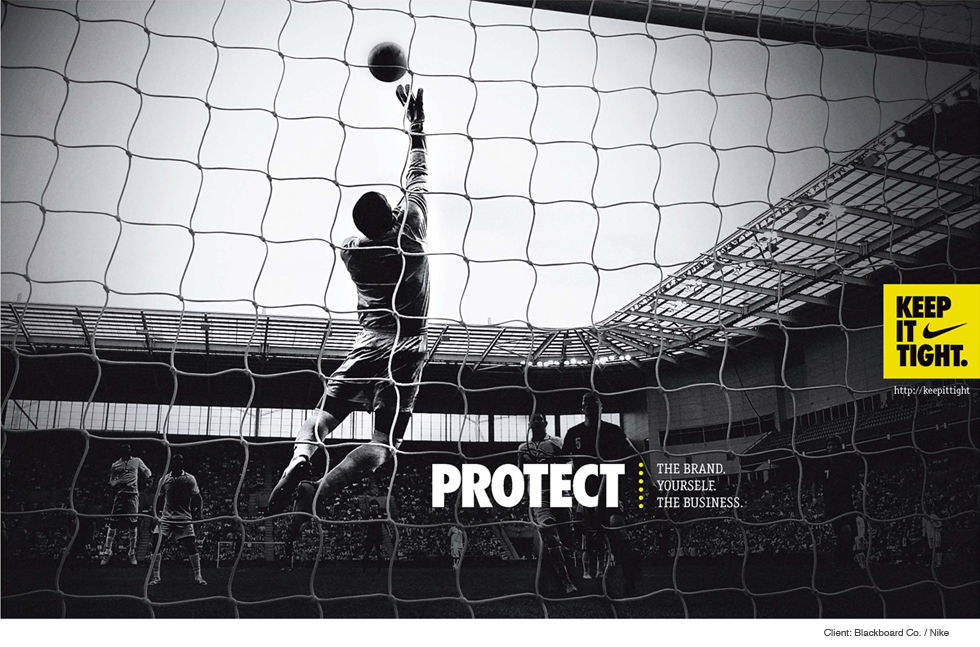
Do you think what you learned at school provided anything more than a basic foundation in technique?
Oh, I think school got me into the profession, but I learned so much more from working with photographers and art directors and other retouchers, from being in the field. Working in pre-production with Jimmy Williams, for example, I got to see how to shoot images that make it easier for compositing later. At McKinney Silvers I worked in the production department and I learned there how to properly deliver and prepare files, another element that’s important not just to re-touching – making sure your channels are all in order, and things you might not see on screen but show up in print. Now, working freelance, I don’t have as much interaction with other people, so it’s really important that I already know those things.
But the most important thing is that you do good work, and do it quickly.
How much of your work comes from Austin, and how much of it comes nationally?
A good portion of it comes from Austin. But I’ve started getting some traffic online. I’ve been getting some work from wedding photographers in Miami, for example. They randomly found me, they like my work, and they’ve been referring me down there. One of my biggest clients is Tom Hussey in Dallas. That came from a blind email when I started freelancing. He liked my work and it’s developed into a really good relationship.
So when someone sends you wedding work, are they giving you a ton of images to work through, or just one or two?
The main one I work with in Florida is pretty successful, so mostly hers are preparing images to appear in magazines, or for exhibit work.
Do you do much marketing?
The past few years have been my best years, and also my busiest with having kids, and I just haven’t had time. It’s all been word of mouth. I’ve been lucky to have really good clients and they’ve stuck with me. I hope it keeps growing. I have a friend who has two kids around the same age as mine, and we’re just waiting for the right time to be able to do more. You know, so that we’re not just freelance, but have a business and bring in more while the kids are in full-time day care and we can really grow a business.
How much of your work is commercial vs editorial?
I’d say about eighty per cent commercial. I do a lot of work for Spirit magazine, and there are a couple of photographers like Tom who I do their commercial work, but then I also help on portfolio or personal work.
Because there’s just no budget for re-touching in editorial work?
Right. But on the other hand, it can be a really cool, creative project, so…
Let’s look at an image on your website. How long did you work on this (Giant) image by Randal Ford?
A couple of long days. Maybe one really long day. Like most photographers, Randal’s really good about shooting in camera to make it easier for you to do the composite. Tom’s another one – he’ll lock down the tripod or whatever. I mean, some photographers will give you one shot and then another from a totally different angle, and that makes things difficult.
Finally, what are your thoughts on the new Adobe business model, wherein you pay monthly for cloud access to their creative suites, since they will no longer be releasing full periodic creative suite updates? I suppose it’s inevitable that you have to climb aboard at some point?
Yes, I see myself going to the subscription if that is the future of the Adobe brand. I am just hesitant to change, and always wait a bit until I make a move. Costs are comparable, but the whole idea of not “owning” the software is a bit worrying, only “renting” access monthly or yearly. I currently own the CS5 suite, so I need to figure this one out somewhat soon. My hesitation is about which package to buy once I make the switch. I work 90% of the time in Photoshop, but I do need access to the latest version of In-design and Illustrator as well. Although I may not use those programs as frequently, I still need them – so do I pay for them monthly as well? That’s the dilemma to work out before making a move.
Favorite Taco:
Whole Foods Breakfast Taco – (egg, black beans, jack cheese, pico, dragon sauce) or Guero’s Shrimp Taco
Favorite BBQ:
My husband’s BBQ chicken and ribs on the smoker at home.
Favorite Beverage:
Margarita, no salt
Favorite Texas Weekend getaway spot:
Downtown Austin, now that we live in suburbia with the kids! Also, the beach anytime!
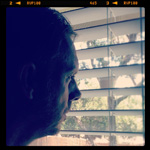
John Davidson is an editorial and commercial photographer (M40 Photography), based in Austin, Texas. John grew up in Manchester, England, and moved to Los Angeles when he was young and reckless. He spent close to a decade living in Brooklyn, NY, where he worked primarily as a freelance writer. He landed in Austin in 2008. John is married, with 1.4 children, at the time of writing. Website*Instagram*Twitter

